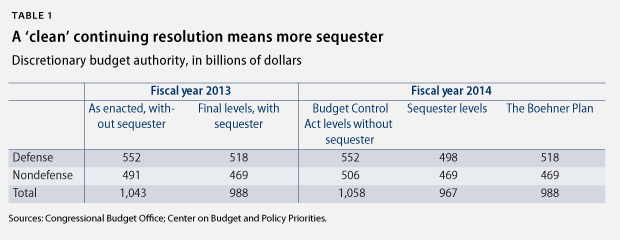Washington, D.C. – House Speaker John Boehner’s (R-OH) expected stopgap funding measure would lay the foundations for another round of damaging cuts to vital programs, services, and investments, according to a new report released today by the Center for American Progress. The analysis, authored by CAP President Neera Tanden and federal budget expert Michael Linden, explains how the speaker’s partisan approach is far from “clean” and is, in fact, indistinguishable from the harmful automatic “sequester” cuts to domestic programs. Furthermore, the funding levels embedded in the speaker’s approach would give defense a $20 billion boost, even while endorsing the entire sequester for nondefense.
“Progressives and centrists in Congress should not accept in a short-term measure what they would surely reject in any other situation,” said Neera Tanden. “Adopting austerity measures through a short-term continuing resolution runs counter to the needs of the economy and the goals for which progressives are fighting to achieve.”
When Congress finally passed a consolidated appropriations package in March, they agreed upon funding levels for the government through the remainder of fiscal year 2013, allocating $552 billion for defense and $491 billion for nondefense for a total of $1,043 billion. These spending levels were in line with spending limits required by the Budget Control Act. But that final appropriations bill did not repeal or adjust the sequester spending cuts. This meant that the appropriated levels were automatically reduced to $518 billion for defense and $469 billion for nondefense due to sequestration, for a final total of $988 billion. That $988 billion level is what the Speaker wants to extend—not the original, enacted levels at $1,043 billion.

As Tanden and Linden explain, by extending last year’s post-sequester levels, Speaker Boehner is attempting to lock those additional spending cuts into place and create a new baseline from which future negotiations must begin. A comparison between the speaker’s plan and merely acceding to the automatic sequester cuts makes it clear why the speaker is pushing his approach. Under the sequester, without any adjustment at all, nondefense funding would be set at $469 billion, and defense would end up with $498 billion. Boehner’s approach would also allocate $469 billion for nondefense, the same amount as the sequester. For defense, the Boehner plan would allocate $518 billion, a $20 billion increase over the sequester. In other words, a continuation of 2013 post-sequester levels is no different than the sequester itself—for nondefense programs in particular. Having Congress adopt those levels in the short term is likely to make it easier for conservatives to keep those cuts in place for the long term.
These spending cuts have not been kind to the U.S. economy. The contraction in federal government consumption and investment has caused a direct drag on economic growth in 8 of the past 10 quarters, including the past three quarters consecutively. Though down from its peak several years ago, the unemployment rate remains greater than the level most forecasters predicted three years ago when Congress began cutting federal spending. For many American families, the recession is not over. Indeed, median household income today is lower than when the Great Recession technically came to a close in June 2009.
It is in this economic context that conservatives in Congress are demanding ever more cutbacks. The Congressional Budget Office reports that implementing the sequester cuts in 2014 will reduce real GDP by 0.7 percent and reduce employment by 900,000 jobs. Since the Boehner approach would cement most of these cuts into place, the immediate negative economic consequences alone should be enough for Congress to reject it.
A second reportreleased today, entitled “Why Austerity Fails When the Cuts Get Specific,” explains why Speaker Boehner needs to employ the ruse of a “clean” resolution to get more cuts through Congress: Even conservatives pushing for a drastic reduction in federal spending have been unable to translate their budget blueprints into actual, specific program cuts that they can support. The report details why Republican leadership in the House of Representatives failed to pass their transportation and housing bill, which represented the sincere effort of Ryan budget supporters to allocate the budget’s spending cuts in the best way possible. When members of Congress saw what these specific cuts actually looked like, they refused to support the bill as it would abandon our nation’s infrastructure to disrepair and obsolesce. Even more egregious, House Republicans have thus far failed to even write the bill that would fund an array of health and education programs at the levels that their proposed overall cuts would necessitate. With the House Republican caucus unable to chart a path forward that adheres to the preposterously large spending cuts they want, with his continuing-resolution proposal, Speaker Boehner is trying to encourage his members to fall back on the only-slightly-less-preposterous sequester spending cuts.
Read the reports:
To speak with an expert on this topic, contact Katie Peters at [email protected] or 202.741.6285.
###